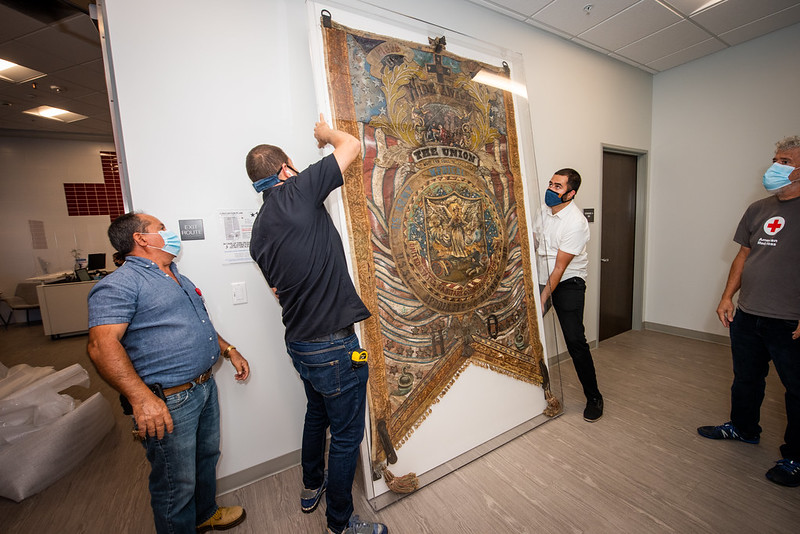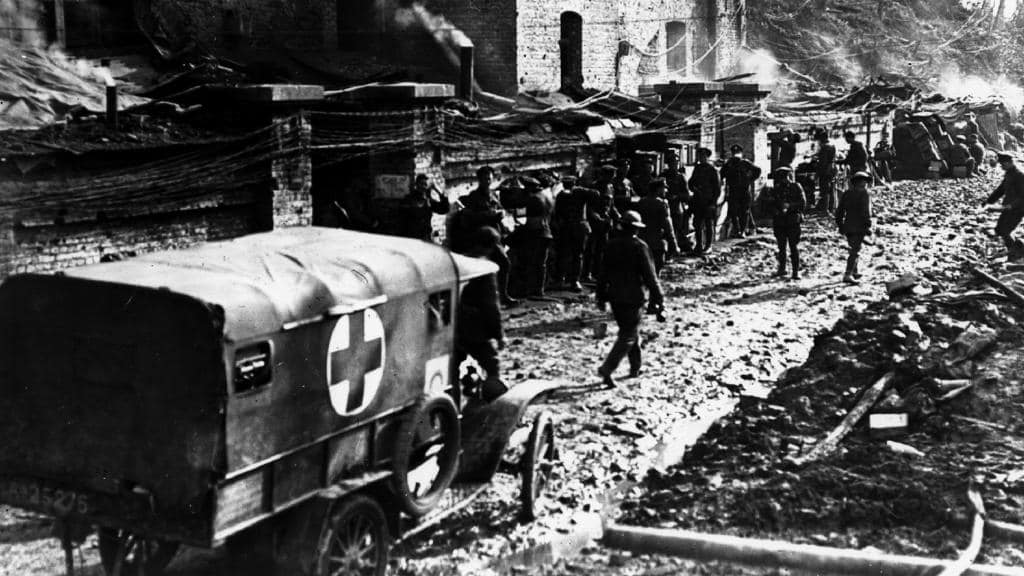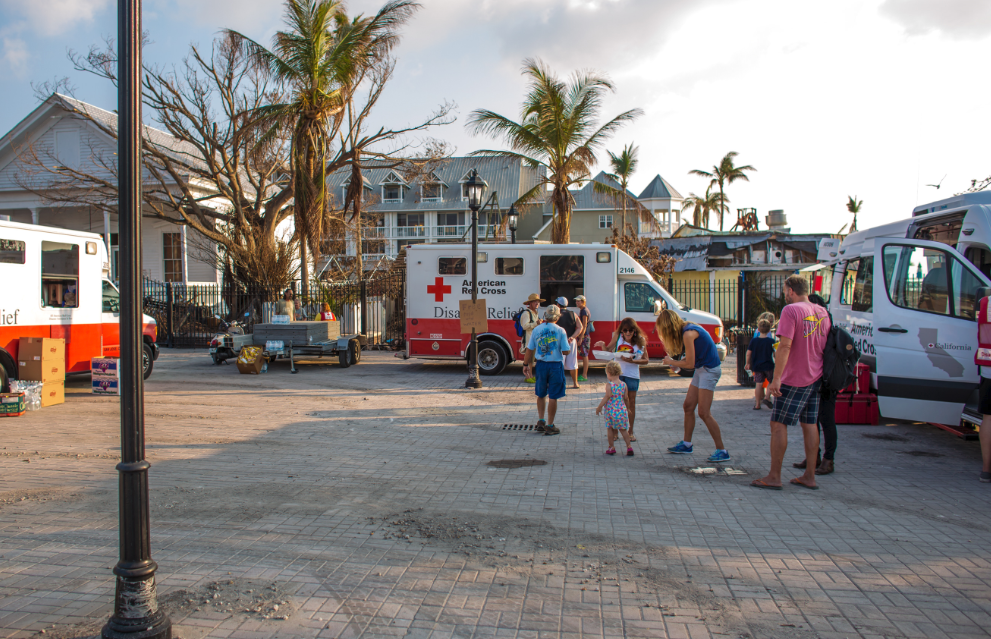By Saida Pagan, Red Cross LA volunteer
It was just another day of unpacking for the staff and volunteers at the American Red Cross Los Angeles Region headquarters. After decades at the West Los Angeles , Veterans Administration campus, the Red Cross had moved to a new office in downtown LA in the summer of 2019.
No one knew for sure what was in many of the old boxes and containers because they hadn’t been opened in quite a while, but nobody anticipated any real surprises.
Inside, they found a treasure trove of old photographs dating back to the 1920s and some Red Cross uniforms showcasing evolving fashion trends over the years. Another interesting find was a number of vintage telephones used to coordinate emergency services during the 1950s and 60s.
But then suddenly, a mundane morning of unpacking took an unexpected turn. Jillian Robertson, the Red Cross LA Digital Communications Manager, along with volunteers decided to unfurl what appeared to be a rolled-up carpet. What happened next would lead to an important discovery in the long and proud history of the American Red Cross. “I was blown away,” Robertson said.
What had initially looked like a carpet was actually nearly 8-foot-long tapestry. “I think we both gasped. It was clearly something historic,” said Robertson.
Worn and frayed, the banner showed a winged female known as the “Angel of the Battlefield,” with a red cross emblazoned across her gown. It was a figure that evoked thoughts of American Red Cross founder Clara Barton—however, the other images that had been hand-stitched into the tapestry appeared to pre-date the American Red Cross which was established in 1881.
Woven into the fabric was a dramatic battle scene seemingly inspired by the American Civil War. The words, “United States Sanitary Commission,” were prominently displayed as well. The US Sanitary Commission was an often-overlooked agency that began operating in 1861 and was charged with caring for wounded Union Army soldiers during the war between the states.
While Robertson and other LA Region staff members didn’t initially know the exact significance of what they had found, they sensed that it had a strong connection to the Red Cross legacy. “It’s clearly a piece of history. It’s something that needs to be preserved,” Robertson remembers thinking.
Susan Watson, the archivist for the American Red Cross in Washington, DC, said despite many unanswered questions surrounding the creation of the ornate work of art, one thing is clear: the reference to the US Sanitary Commission is an important reminder of the sometimes-forgotten connection between the US Sanitary Commission and the American Red Cross. “The US Sanitary Commission is considered the precursor to the American Red Cross. That’s where the link is between the two organizations,” Watson said.
Although Red Cross founder Clara Barton did not play a major role in the Sanitary Commission, Watson said that Barton sometimes got medical supplies and transportation assistance from the Commission, which raised money for medical care, facilities, doctors and nurses for the Union Army. In fact, according to Watson, some of the Commission administrators had wanted to create a Red Cross-like organization based on the international model and even attended meetings in Geneva, Switzerland.
But when the Civil War ended, the idea did not receive political backing and so the Sanitary Commission eventually disbanded in the 1870s. Nevertheless, the Sanitary Commission’s humanitarian work had made a huge impression and several years later, Clara Barton was able to realize the dream that many had worked long and hard for. “She was part of that whole mindset of what they were trying to do and what she was trying to do. The Sanitary Commission maintained loose ties with the International Red Cross. They were all working towards a common goal. So yes, this banner is part of that goal. It’s amazing.” Watson observed.
Further research showed that the tapestry had been given to the LA Region a few years earlier by a donor who reportedly stated that the banner had been acquired at auction and had once been owned by prominent collectors. The Red Cross was also presented with a letter from the Smithsonian National Museum of American History stating that the staff had examined photographs and believed that the banner could have been created as early as the mid 1860s.
The staff at the LA office was so in awe of the majestic piece that their first thought was how something so rare truly belonged at the national headquarters in Washington, DC. But when logistical challenges nixed that idea, the LA Region came up with a plan to restore what appeared to be a link to the Red Cross’ past. “That’s when we reached out to Iron Mountain,” said Jarrett Barrios, the former Chief Executive Officer of the LA Region Red Cross. Iron Mountain is a major US information management and storage company, “They have a foundation, and they give money for historic preservation and restoration. We reached out to them, and we got the grant, and we were able to do the work,” Barrios said.
A few months later, the “crown jewel,” of the LA Region artifacts had been preserved, mounted and today proudly hangs on a wall at their office.
But the story doesn’t end there. While the “Angel of the Battlefield,” banner now has a new home, a new life and new admirers, questions remain about its origin and how it found its way to Los Angeles.
One major question is why the banner was created in the first place. There are a few interesting theories. One possibility is that it may have been a commemorative piece. The name of a Dr. Godfrey Aigner is displayed on the tapestry. Auction documents describe Aigner, as having been appointed to the US Sanitary Commission to be President Abraham Lincoln’s “eyes and ears” within the agency. The date, June 9, 1861, is inscribed on the tapestry.
Then there is the mystery of exactly when the historic banner was designed. Although the letter from the Smithsonian Institution states that it may have been completed between 1866 and 1881 or later, other experts believe it was done closer to the time of the Civil War which ended in 1865. They explain that the image of an angelic female figure with a red cross across her gown was a symbol of humanitarian outreach that predated the American Red Cross.
And finally, where has the tapestry been all these years? The auction house description says that it was housed in a museum in England during the 1930s through the 1950s. But where it has been for the past 60 years is a question, whose answer will just have to wait for the time being.
Right now, the focus is on the profound story the tapestry must tell. “I think it’s wonderful that it survived all this time,” Watson said. “There’s a lot of backstory that goes on that you don’t hear about as much. So, I think it helps tell a fuller story of the Sanitary Commission in influencing people to better care for soldiers and for all people in times of war and disaster,” Watson concluded.
Former Red Cross CEO, and life-long Red Cross supporter and volunteer, Jarrett Barrios agreed. ” It gives me particular pride to see not only how we value our mission, but also the historic nature of our mission—that we are not just the largest, volunteer organization in the country, but that we are one of the oldest, and the work that we are doing is in the tradition of people that go back 150 years. This tapestry is confirmation of that.”
To see photos of the “Angel of the Battlefield” tapestry, click here: https://www.flickr.com/photos/redcrosslaregion/albums/72157715291498478





